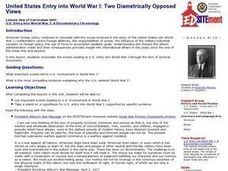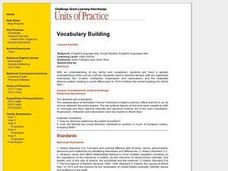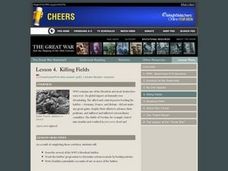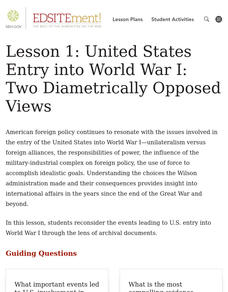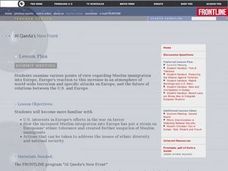National Endowment for the Humanities
How to Win a World War
High schoolers are have begun to learn the art of diplomacy with each other, but do they understand how diplomacy works at a global level? The second in a series of four lessons, guides scholars in evaluating primary sources....
Curated OER
United States Entry into World War I: Two Diametrically Opposed Views
Students analyze the events leading to U.S. entry into World War I. They read a speech by President Wilson and an opposition speech, list the reasons each gives for American entry into the war, and complete a Venn diagram.
National Endowment for the Humanities
How "Grand" and "Allied" Was the Grand Alliance?
Learn more about the Grand Alliance with a scaffolded lesson plan that includes four activities. Class members use primary sources to complete a map exercise, understand the goals and objectives of each individual nation, and participate...
Curated OER
World War I: War in a Democratic Society
Students research opposition and support for World War I from a number of perspectives. They analyze a number of primary and secondary sources, while considering what (if anything) makes a war just and write a letter expressing his/her...
National Endowment for the Humanities
The New Order for "Greater East Asia"
Sometimes the New Order becomes synonymous with its implications for European countries, but what about its consequences for East Asia? The final instructional activity in a four-part series teaches scholars about World War II. High...
Curated OER
Lesson 3. No One Spared
Eleventh graders, in groups, explore the devastation that World War I inflicted on millions of people around the world. They write a first-hand account of the impact of World war I.
Curated OER
Causes of WWI-Introductory Lesson
Sixth graders identify the causes of World War I. In this World War I history lesson, 6th graders view a Powerpoint to develop background knowledge about World War I. Students make a picture map of the events that led to war and...
Curated OER
Vocabulary Building - World War I
Students study the definitions of militarism, imperialism, and nationalism, and the significant individuals involved in the world alliance system prior to 1914. They examine the events that lead to World War I.
American Battle Monuments Commission
Entering Italy: The Naples-Foggia Campaign
The second half of 1943 found Allied soldiers struggling to separate Italy from the Axis Alliance and to solidify the new Italian government under Prime Minister Pietro Badoglio. High schoolers take a deeper look at the intricacies of...
National Endowment for the Humanities
Victory and the New Order in Europe
A New Order in Europe calls for a new lesson plan! This third plan in a series of four sequential lessons encourages high schoolers to read primary sources about the development of the New Order and follow up their knowledge with a...
Curated OER
Lesson 4. Killing Fields
Eleventh graders describe several of the WWI's bloodiest battles, track the battles' progression to determine advances made by leading nations, and write frontline journalistic accounts of one or more of the battles.
Curated OER
World War II - War Comes to Hawaii
Ninth graders use geographic representations to organize, analyze, and present information on people, places, and environments. They use tools and methods of geographers to construct, interpret, and evaluate qualitative and quantitative...
Curated OER
Mapping and Personifying Nations
Eleventh graders analyze the geography, actions, and relationships of countries involved in World War II. They create a map of Europe, Northern Africa, and the Pacific, and analyze and evaluate their self-made map of Europe and the...
Curated OER
The Early Tensions of the Cold War
Students uncover the roots of the Cold War. In this Cold War lesson, students research the political philosophies of the Soviet Union and the United States during the era as they define key vocabulary and discuss government systems....
Curated OER
The Vietnam War
Students acquire information about the Vietnam War Era from the internet, textbook and various sources. They transfer the information that they have acquired into a newspaper format. Students create editorials, cartoons, graphics and...
Curated OER
Friends or Foes?
Students discuss Spain's relationship with Europe and the U.S. and research incidents of American-European disagreements regarding international actions and policy. They write essays on how the world might be different if a multipolar...
Curated OER
Hiroshima, From All Sides
Students comprehend how the Atomic Bomb affected humanity and ended WWII. They comprehend how the Atomic Bomb affected: scientists, Japanese citizens, and US leaders. Students receive a copy of Hiroshima, Readers Theater Rubiv. They...
Curated OER
United States Entry into WWI: Two Diametrically Opposed Views
Young scholars reconsider the events leading to US entry into WWI through the lens of archival documents.
Curated OER
Wilson Stands Alone in His Plan for World Peace
Students study the Fourteen Points. They examine motives behind Wilson's Fourteen Points and why most of them were rejected by France. They answers questions concerning primary resources (casualty list and before and after...
Curated OER
The Bush Doctrine
Students analyze the Bush Doctrine and its effects on foreign policy. In this foreign policy activity, students read and discuss the Bush Doctrine. Students research and debate on whether or not the Bush Doctrine should be part of U.S....
Curated OER
Sparking a Revolution!
Students investigate the causes and events that lead to the US Revolutionary War. They use a number of study techniques in this unit to discuss why the colonies wanted freedom from Britain.
Curated OER
Summit Meeting
Students examine various points of view regarding Muslim immigration into Europe. They view and discuss the PBS Frontline video, "Al Qaeda's New Front," read and discuss articles, and present information about their article in a jigsaw...
Curated OER
Salt: White Gold
Students examine the importance of salt for trade routes and the economy of a community.
Curated OER
Migration - An African-American Adventure During WWI
Sixth graders explore the push/pull factors that influenced the South to North migration. In this African-American migration lesson, 6th graders read an article and answer comprehension questions. Students write a letter to the...

